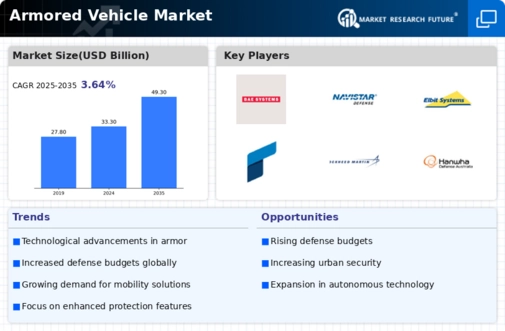Top Industry Leaders in the Armored Vehicles Market

Strategies Adopted: In the fiercely competitive Armored Vehicle market, key players employ strategic approaches to a competitive edge. Continuous investment in research and development (R&D) stands as a cornerstone, enabling companies to introduce next-generation armored platforms equipped with enhanced protection, mobility, and firepower. Strategic collaborations with military agencies, international partnerships, and alliances facilitate technology transfer, fostering the development of specialized armored vehicles tailored to specific operational needs. Global market expansion through defense contracts, international sales, and the establishment of production facilities in key regions ensures a broad market reach, allowing companies to meet the diverse requirements of defense forces worldwide.
Competitive Landscape of Armored Vehicle Market
- BAE Systems PLC (UK)
- Lockheed Martin Corporation (US)
- Rheinmetall AG (Germany)
- International Armored Group (US)
- Krauss-Maffei Wegmann GmbH & Co. (Germany)
- Elbit Systems Ltd (Israel)
- General Dynamics Corporation (US)
- INKAS Armored Vehicle Manufacturing (Canada)
- Mitsubishi Heavy Industries Ltd (Japan)
- Oshkosh Corporation (US)
- Diehl Defence GmbH & Co. KG (Germany).
- BAE Systems PLC (UK)
Factors for Market Share Analysis: Market share analysis in the Armored Vehicle market involves considering various factors crucial to a company's competitive standing. Technical capabilities, encompassing the ability to offer a comprehensive array of armored vehicles, from main battle tanks to wheeled armored personnel carriers, play a pivotal role. Companies providing adaptable and modular armored solutions capable of addressing diverse threats are better positioned to capture a larger market share. Compliance with stringent military standards, armor protection levels, mobility, and integration of advanced technologies contribute significantly to market share dynamics. Additionally, factors such as lifecycle support, maintenance services, and overall cost-effectiveness influence a company's market share by enhancing the overall value proposition for defense customers.
New and Emerging Companies: While established players dominate the market, new and emerging companies are making significant contributions to the innovation and evolution of armored vehicle solutions. Companies like Arquus and Paramount Group are gaining recognition for their specialized armored vehicles, often focusing on modular designs, hybrid propulsion systems, and advanced situational awareness technologies. Emerging companies often bring agility and a fresh perspective to the Armored Vehicle market, introducing novel approaches and technologies that address the evolving needs of modern armed forces.
Industry News: Recent industry news in the Armored Vehicle market underscores ongoing developments and trends shaping the sector. Innovations in composite armor materials, active protection systems, and integrated sensor suites are gaining prominence, enhancing the survivability and capabilities of armored vehicles. News often covers advancements in modular vehicle architectures for scalability and mission adaptability, allowing for flexible deployment across diverse operational environments. Additionally, developments in hybrid-electric propulsion systems and the integration of artificial intelligence for enhanced autonomous capabilities highlight the industry's commitment to staying ahead of emerging threats and technological advancements. Industry news reflects the dynamic nature of the Armored Vehicle market, with continuous efforts to improve survivability, mobility, and mission versatility.
Current Company Investment Trends: Investment trends in the Armored Vehicle market underscore a commitment to technological innovation, sustainability, and global reach. Companies are allocating substantial resources to R&D initiatives focused on advanced armor materials, survivability technologies, and autonomous vehicle capabilities. Investments in sustainability practices, including the development of hybrid and electric armored platforms, align with the defense industry's broader environmental goals. Strategic acquisitions of technology startups, partnerships with research institutions, and collaborations with international defense contractors contribute to a comprehensive approach, ensuring a continuous stream of cutting-edge solutions and maintaining a competitive stance in the market.
Overall Competitive Scenario: The overall competitive scenario in the Armored Vehicle market reflects a balance between established industry leaders and emerging companies that bring innovation and flexibility to the sector. Established defense contractors leverage their extensive experience, global reach, and comprehensive armored vehicle portfolios to set industry standards. Simultaneously, emerging companies contribute to the diversification of Armored Vehicle solutions, often focusing on specific applications or introducing disruptive technologies. The industry's response to evolving military requirements, technological advancements, and emerging threats highlights the adaptability and resilience of Armored Vehicle providers. As armed forces globally seek more advanced and versatile armored platforms, the Armored Vehicle market is poised for continued evolution. The emphasis on technological advancements, strategic collaborations, and meeting the dynamic needs of modern warfare positions this market as a critical enabler for military capabilities in armored protection, mobility, and strategic operations.
Recent Development:Top of Form
December 2022, Japan chose Patria-manufactured Armored Modular Vehicles (AMV) as the replacement for the Japan Ground Self-Defense Force's Type-96 8X8 wheeled armored personnel carriers.
March 2023, officials from Australia and Germany inked an agreement for collaboration in acquiring new combat reconnaissance vehicles. These vehicles, based on the Boxer family of armored fighting vehicles and armed with a 30-millimeter gun, are slated for delivery commencing in 2025.


